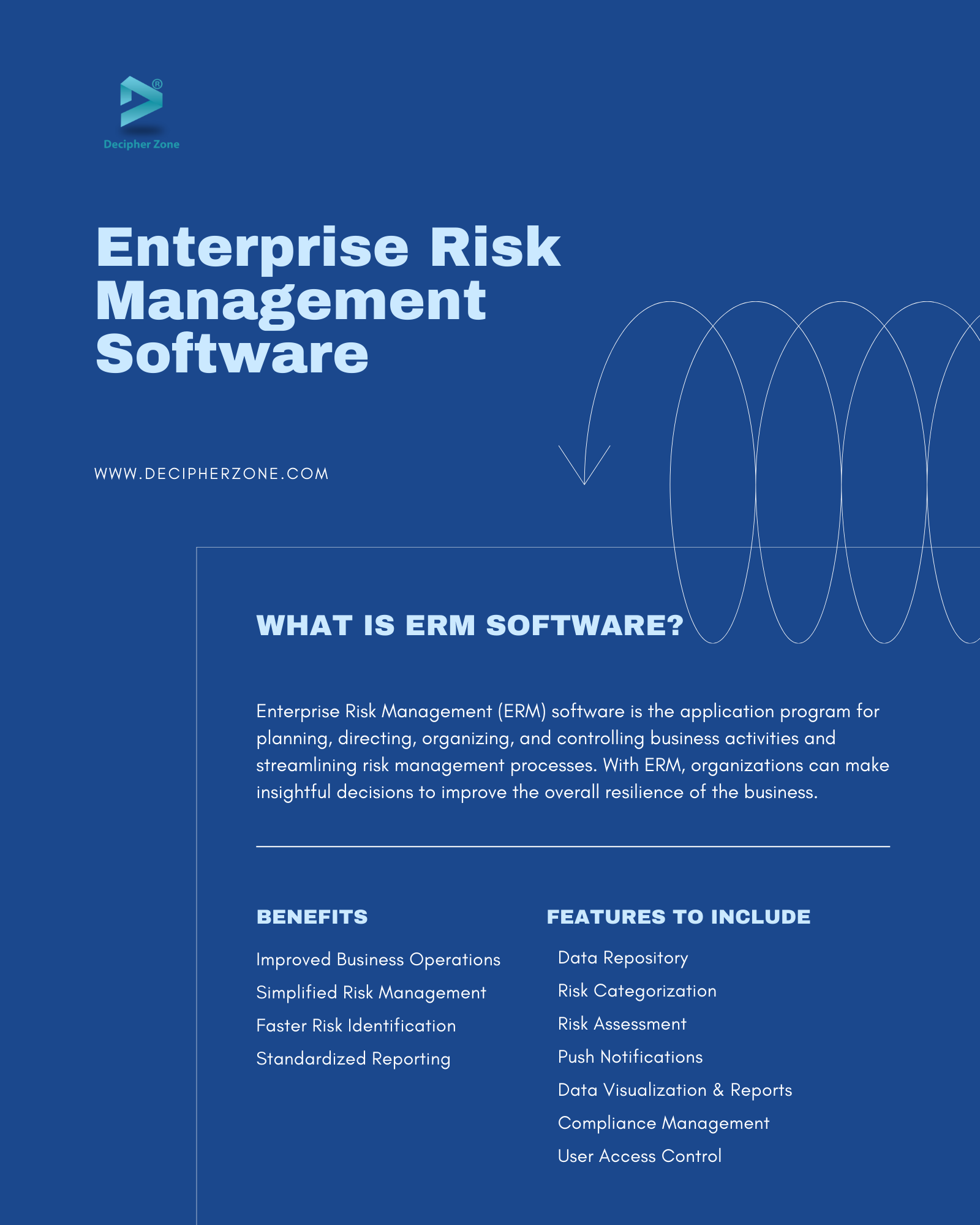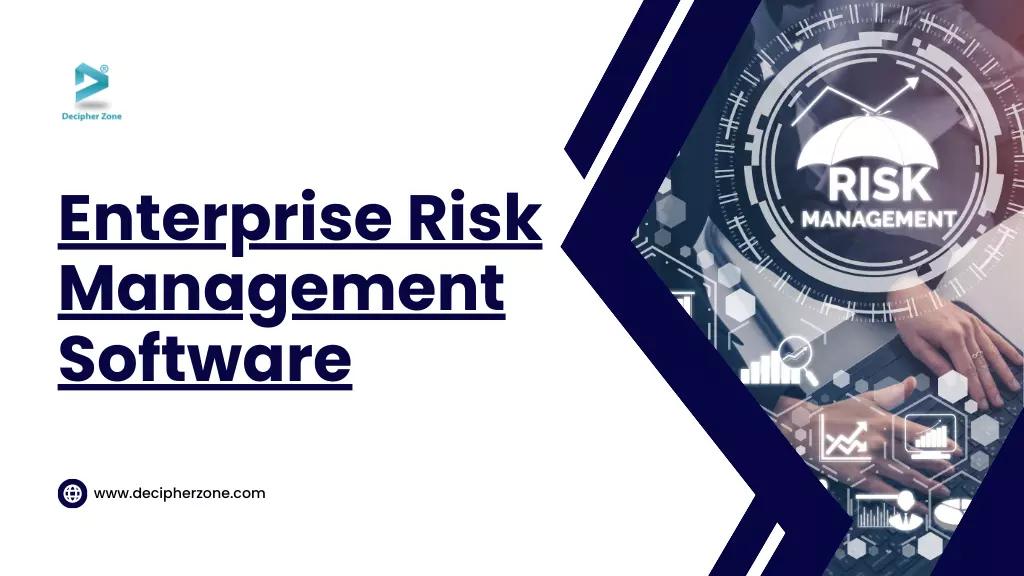Enterprise Risk Management Software Development: Benefits & Features, Cost. With technological advancements, risks are continuously on the rise. That being said, organizations are more likely to face challenges that impact their finances, operations, and reputation.
From rapidly fluctuating markets to regulatory changes and cyber threats, businesses navigate through a constantly changing sea of risks.
The most reliable solution to overcome this obstacle is Enterprise Risk Management Software.
Enterprise Risk Management Software: How to Build a Custom One?
In this blog, we will dive into the world of ERM software, exploring what it is, its benefits, features, etc. so that you can build one for your business.
What is Enterprise Risk Management Software?
Enterprise Risk Management (ERM) software is the application program for planning, directing, organizing, and controlling business activities and streamlining risk management processes. ERM helps businesses to detect, assess, mitigate, and monitor risks in a centralized platform. With ERM, organizations can make insightful decisions to improve the overall resilience of the business.
Read: ERP Application Development
Dedicated ERM systems are crucial for businesses that regularly deal with vast amounts of sensitive information and multiple stakeholders to approve strategic decisions. Some industries where ERM has become a standard system are healthcare, finance, construction, insurance, and information technology (IT).
Read: Field Service Management Software Development
Benefits of Enterprise Risk Management Software Development
Some of the advantages that Enterprise Risk Management software provides to a company are as follows:
-
Improved Business Operations
-
Simplified Risk Management
-
Faster Risk Identification
-
Standardized Reporting
Improved Business Operations: An ERM system helps businesses identify and handle risks at early stages with real-time risk indicators and analytics. ERM software can also calculate possible delays, shortage of resources, etc., allowing organizations to make informed decisions and streamline business processes.
Simplified Risk Management: ERM makes it easier to track and manage risky processes. This software analyzes risks and sends immediate alerts about threats as soon as they arise, giving you time to review and mitigate them efficiently. Also, by collecting data from multiple silos, it frees up your team from repetitive tasks and allows them to focus on other important tasks.
Faster Risk Identification: It is stressful for any enterprise to undergo an in-depth audit. However, it can be avoided by using the ERM software system. This system automates regulation compliance management to keep the organization secure and compliant. Other than that, it also logs and categorizes all the files in the system making it easier for auditors to review processes much faster.
Standardized Reporting: It helps organizations implement standardized reporting of risks that help with long-term metrics.
Read: Best Practices for ERP Implementation

Features of Enterprise Risk Management Software
Depending on your business unique requirements and objectives are more likely to vary, but some of the important features that you need to integrate into your ERM software are:
-
Data Repository
-
Risk Categorization:
-
Risk Assessment
-
Push Notifications
-
Data Visualization & Reports
-
Compliance Management
-
User Access Control
Data Repository: An ERM software must contain a data repository that can collect risk details and corresponding strategies to mitigate them. The data elements in the repository should be easily accessible and include categories, descriptions, hierarchy, and responsible stakeholders. It also allows users to store and organize large data sets securely. Overall, the data repository is implemented to meet regulatory requirements while providing a reliable data retention solution and ensuring your team has a plan for every risky incident.
Risk Categorization: Using Enterprise Risk Management Software businesses can create distinct categories and subcategories of risks that align with the predetermined risk management strategy and framework.
Risk Assessment: Including analytics features in the ERM software will allow companies to determine the outcome of the risk. You can also connect existing software systems to the ERM via APIs or by adding data manually. Businesses can use ERM to evaluate risks based on their potential impact for better risk management and mitigation.
Push Notifications: Adding this feature allows users to get real-time notifications on their devices about any risk that might occur and its impact. With push notifications, your team doesn’t have to stick to the screen to oversee the metrics. Instead, the software allows them to set thresholds for different processes and send push notifications in case of possible threats.
Data Visualization & Reports: By integrating data visualization and reporting in the custom ERM software, businesses can gain clear insights about risk trends and performance.
Compliance Management: It is compulsory for organizations to adhere to industry compliance and regulatory standards. This feature allows businesses to track and maintain internal standards and industry law compliances.
User Access Control: ERM software should also integrate a user access control option to ensure that only authorized individuals can view and modify sensitive information, reducing the risk of data theft and other security issues.
Read: Facility Management Software Development
Apart from the above-mentioned features, enterprise risk management software can also have additional features such as mobile accessibility, training and support, scalability, customization, third-party integration, document & knowledge management, incident management, and more.
Needless to say, by adding these features to the ERM, your organizations can proactively identify, assess, manage, and monitor risks in order to achieve their business goals and protect their assets.
Read: Introduction to Enterprise Resource Planning (ERP)
How much does it cost to build custom ERM Software?
Developing ERM software can cost you anywhere between $50,000 to $300,000 depending on the complexity, customization, integration, features, tech stack, maintenance, and support required.
Wrapping it Up
Integrating Enterprise Risk Management Software in a business environment can ease recognizing, monitoring, and mitigating risks. If you are looking to develop a custom enterprise risk management software for your organization, then get in touch with our experts and share your requirements. We will help you document your requirements, hire a dedicated ERM development team, choose the right tech stack, and build the software within your budget that easily meets your business needs.
FAQs: Enterprise Risk Management Software Development
What is Enterprise Risk Management?
Enterprise Risk Management (ERM) software is the application program for planning, directing, organizing, and controlling business activities and streamlining risk management processes.
What are the must-have features of ERM software?
Some of the must-have features of ERM software are:
-
Data Repository
-
Risk Categorization
-
Risk Assessment
-
Push Notifications
-
Data Visualization & Reports
-
Compliance Management
-
User Access Control

